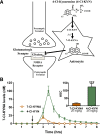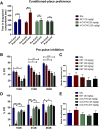The Prodrug 4-Chlorokynurenine Causes Ketamine-Like Antidepressant Effects, but Not Side Effects, by NMDA/GlycineB-Site Inhibition
- PMID: 26265321
- PMCID: PMC4576668
- DOI: 10.1124/jpet.115.225664
The Prodrug 4-Chlorokynurenine Causes Ketamine-Like Antidepressant Effects, but Not Side Effects, by NMDA/GlycineB-Site Inhibition
Abstract
Currently approved antidepressant drug treatment typically takes several weeks to be effective. The noncompetitive N-methyl-d-aspartate (NMDA) receptor antagonist ketamine has shown efficacy as a rapid-acting treatment of depression, but its use is associated with significant side effects. We assessed effects following blockade of the glycineB co-agonist site of the NMDA receptor, located on the GluN1 subunit, by the selective full antagonist 7-chloro-kynurenic acid (7-Cl-KYNA), delivered by systemic administration of its brain-penetrant prodrug 4-chlorokynurenine (4-Cl-KYN) in mice. Following administration of 4-Cl-KYN, 7-Cl-KYNA was promptly recovered extracellularly in hippocampal microdialysate of freely moving animals. The behavioral responses of the animals were assessed using measures of ketamine-sensitive antidepressant efficacy (including the 24-hour forced swim test, learned helplessness test, and novelty-suppressed feeding test). In these tests, distinct from fluoxetine, and similar to ketamine, 4-Cl-KYN administration resulted in rapid, dose-dependent and persistent antidepressant-like effects following a single treatment. The antidepressant effects of 4-Cl-KYN were prevented by pretreatment with glycine or the α-amino-3-hydroxy-5-methyl-4-isoxazolepropionic acid (AMPA) receptor antagonist 2,3-dihydroxy-6-nitro-7-sulfamoyl-benzo[f]quinoxaline-2,3-dione (NBQX). 4-Cl-KYN administration was not associated with the rewarding and psychotomimetic effects of ketamine, and did not induce locomotor sensitization or stereotypic behaviors. Our results provide further support for antagonism of the glycineB site for the rapid treatment of treatment-resistant depression without the negative side effects seen with ketamine or other channel-blocking NMDA receptor antagonists.
Copyright © 2015 by The American Society for Pharmacology and Experimental Therapeutics.
Figures





References
-
- Barr LC, Heninger GR, Goodman W, Charney DS, Price LH. (1997) Effects of fluoxetine administration on mood response to tryptophan depletion in healthy subjects. Biol Psychiatry 41:949–954. - PubMed
Publication types
MeSH terms
Substances
Grants and funding
LinkOut - more resources
Full Text Sources
Other Literature Sources

